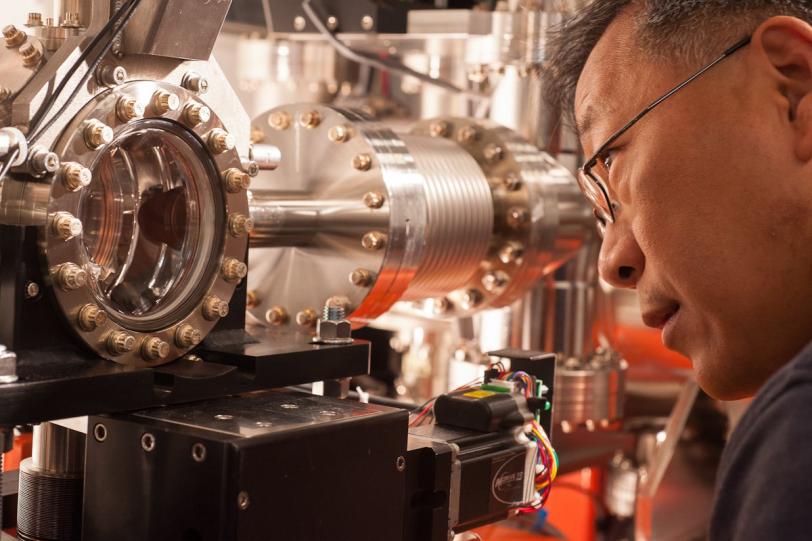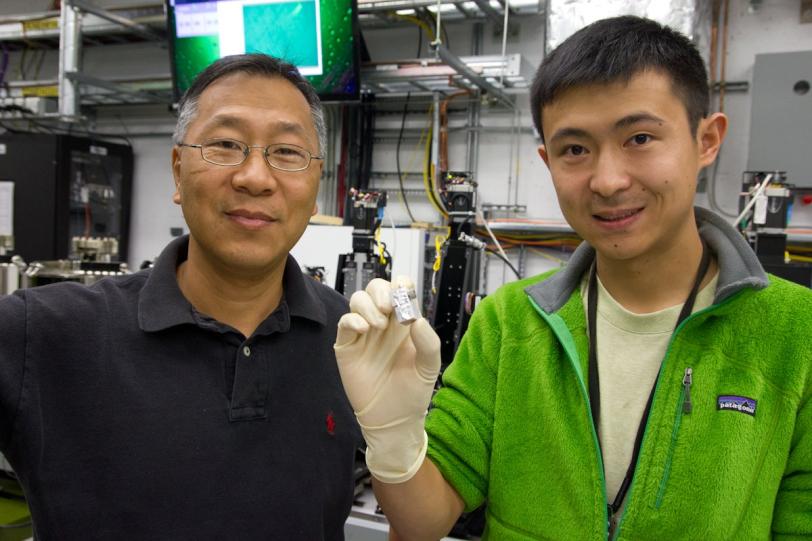Bendable Crystals Resolve Properties of X-ray Pulses
A frustrating flaw in a set of custom crystals for an instrument at SLAC National Accelerator Laboratory inspired a solution for an important scientific challenge: how to accurately measure the colors of each individual pulse from a powerful X-ray laser.
By Glenn Roberts Jr.
A frustrating flaw in a set of custom crystals for an instrument at SLAC National Accelerator Laboratory inspired a solution for an important scientific challenge: how to accurately measure the colors of each individual pulse from a powerful X-ray laser.
The ultra-thin silicon crystals were part of an effort to split X-ray laser pulses from SLAC’s Linac Coherent Light Source so they could be shared by two separate experiments, said Yiping Feng, a staff scientist in the X-ray Science Research and Development Division at SLAC.
Fabricated by a company that specializes in microscopic electromechanical devices, the silicon crystals "need to be as perfect as you can get for beam-sharing," Feng said. But testing at SSRL by Feng and Diling Zhu, who is now an instrument scientist at the LCLS, revealed obvious flaws in one batch of samples.
"They were actually upsettingly wrinkled," Feng said, "apparently bent during their processing. We just wanted to have a look and measure how bad the bending was."
Measurements of the curvature gave the researchers an idea that would lead to an important breakthrough: By sending LCLS pulses through a bent crystal, they could divert a small part of the light and break it into its component wavelengths for analysis – much as a prism breaks visible light into colors – while still sending the bulk of the light to experiments downstream.
Like an erratic baseball pitcher, the LCLS serves up pulses that can vary in location, pulse energy, duration and other properties. Researchers need precise measurements of these properties on a pulse-by-pulse basis so they can correctly interpret their experimental results and troubleshoot and tune the machine for best performance. Simply averaging out the pulse variations doesn't always work.
The LCLS’s Henrik Lemke sacrificed a few hours of his own in-house beamtime on the X-ray Pump-Probe (XPP) instrument to allow testing of the device, known as a spectrometer. The first demonstration required a bit of improvisation, with researchers using double-sided tape to hold the wrinkled crystals in place.
Feng and Zhu later designed new versions of the thin crystals, as well as a delicate fixture to bend them in a controlled way. Working with a team of SLAC researchers that included David Fritz, Aymeric Robert and Jerry Hastings, the scientists incorporated those crystals into a high-resolution spectrometry system for monitoring the X-ray laser's characteristics for every pulse.
Shaped like a curved diving board, the spectrometer features a crystal membrane that is one-hundredth of a millimeter thick, 5 millimeters wide and 15 millimeters long. The free end of the diving board can be controlled to achieve the optimal spectral specifications.
The spectrometer played a critical role in confirming the success of a newly developed technique at LCLS, known as self seeding, that can produce more refined, higher-spectral-brightness pulses useful for a range of experiments.
In fact, it was the high-priority effort to achieve self-seeding that kicked research and development for the spectrometer, which began about a year ago, into high gear.
"We decided, after the initial demonstration, that we would have to build something in time to help the self-seeding commissioning," Feng said. "This was really teamwork – there were a lot of scientists contributing to the effort." The research team detailed their work in a paper published in the July 16 edition of Applied Physics Letters.
The spectrometer captured a now-well-known image of a massive spectral spike in a self-seeded LCLS X-ray pulse – the first successful demonstration of self-seeding at a hard X-ray free-electron laser.
"This was the single most important signature of the seeding process," Feng said. Without self-seeding, each X-ray pulse typically contains a range of wavelengths that look like a random sequence of peaks and valleys.
Shortly after the self-seeding demonstration, the project's lead engineer, Dave Rich, quickly built a permanent, fixed-energy spectrometer in the LCLS Front End Enclosure to help accelerator scientists achieve better seeding performances. LCLS users can now choose seeding as an option for a variety of experiments.
Zhu said the development of the spectrometer "was a really impressive, quick project" and "helped to reveal a lot of beam properties that were previously unseen."
There is very active research to develop an improved spectrometer that can measure the spectral characteristics of the beam for a far broader range of X-ray energies, he said. "Our final goal is to be able to provide a full spectrum with very high resolution" across the whole hard X-ray energy range at LCLS, Zhu said.
The compact design and easy installation of the spectrometer setup may make it possible for each LCLS instrument to someday have its own spectrometer. "We do envision that we're going to come up with a better device used for every hard X-ray instrument," Zhu said. "We see a fair amount of user demand."
Zhu and Feng noted that there are some radically different designs under consideration for the next-generation spectrometers for both soft and hard X-rays. Despite their tremendous advantages in achieving ultrahigh resolution for some experiments, the thin silicon crystals have some inherent limitations and cannot currently be used with all LCLS experiments.

